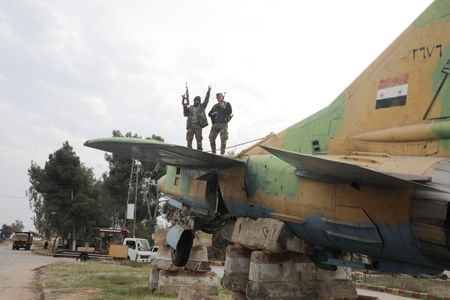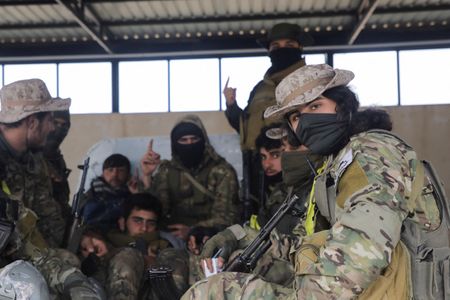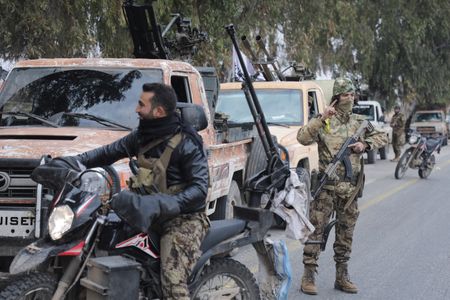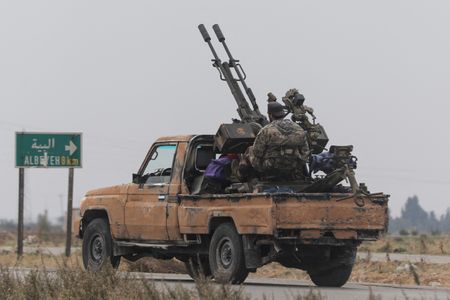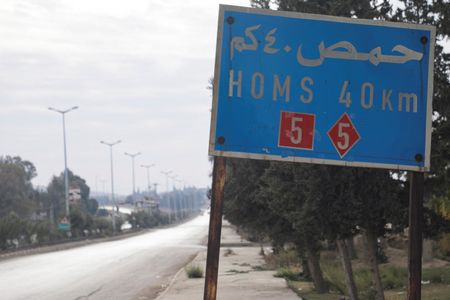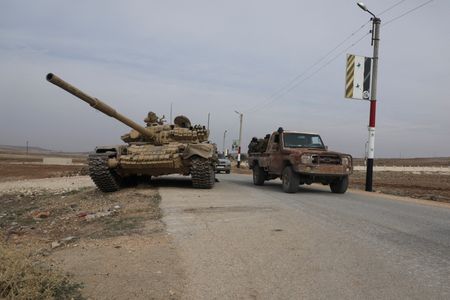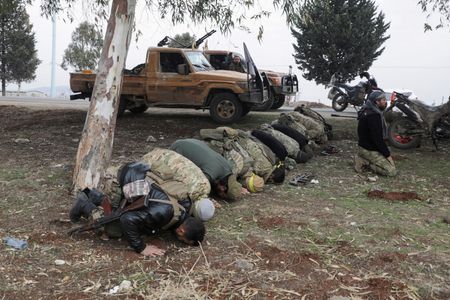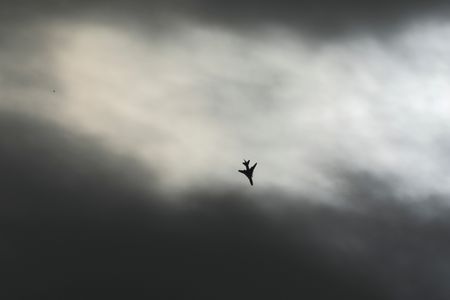By Suleiman Al-Khalidi and Timour Azhari
AMMAN/BEIRUT (Reuters) -Syrian government forces abandoned the key city of Homs on Saturday after less than a day of fighting, leaving President Bashar al-Assad’s 24-year rule dangling by a thread with insurgents also advancing towards the capital Damascus.
Since the rebels’ sweep into Aleppo a week ago, government defences have crumbled at dizzying speed as rebels seized a string of major cities and reignited a rebellion in places it had long seemed dead.
The fall of Homs and threat to the capital now pose an immediate existential danger to the Assad dynasty’s five-decade reign over Syria and the continued influence there of its main regional backer, Iran.
The most powerful insurgent leader, Abu Mohammed al-Golani, said in a statement that rebels were on the cusp of taking the whole country and “the end of the criminal regime is near”.
Assad’s government may be on the verge of collapse, foreign officials told Reuters on condition of anonymity. One U.S. official put the potential timeframe at five to 10 days while another said Assad could be ousted in the coming week. A Western official agreed with the latter assessment.
Seizing Homs, an important crossroads between the capital and the Mediterranean, effectively cuts off Damascus from the coastal stronghold of Assad’s minority Alawite sect, and from Russia’s air and naval base.
The Syrian army and security commanders left Homs on Saturday by helicopter for the coast while a large military convoy withdrew by land, a senior army officer said. Rebels said they were entering the city centre.
Thousands poured onto the streets there to celebrate, residents said.
Homs residents and rebels said the insurgents had captured the central prison and were freeing thousands of detainees. Residents said state security and intelligence personnel had evacuated their offices after burning papers.
Insurgents have seized almost the entire southwest within 24 hours, and they have advanced to within 30 km (20 miles) of Damascus as government forces fell back, rebels said.
Underscoring the possibility of an uprising in the capital, protesters took to the streets in several Damascus suburbs, ripping up Assad posters and tearing down a statue of his father, former President Hafez al-Assad, uncontested by army or police. Some were joined by soldiers who had changed into civilian clothes and deserted, residents said.
However, the state news agency reported that Assad remained in Damascus, and the military said it was reinforcing around the capital and south.
ALARM AMONG GOVERNMENTS INCLUDING RUSSIA
The pace of events has stunned Arab capitals and raised fears of a new wave of regional instability.
Qatar, Saudi Arabia, Jordan, Egypt, Iraq, Iran, Turkey and Russia issued a joint statement saying the crisis was a dangerous development and calling for a political solution. But there was no indication they agreed on any concrete steps, with the situation inside Syria changing by the hour.
Syria’s civil war, which erupted in 2011 as an uprising against Assad’s rule, dragged in big outside powers, created space for jihadist militants to plot attacks around the world and sent millions of refugees into neighbouring states.
In the south, the rapid collapse of government control could allow a concerted assault on the capital, the seat of Assad’s power, where residents said electricity cut out on Saturday.
The Syrian military pulled back as far as Saasa, 30 km (20 miles), from Damascus to regroup, a Syrian army officer said.
In the city’s southern suburb of Jarmana, protesters pulled down a statue of Hafez al-Assad, the president’s father. Soldiers were deserting in the former rebel stronghold of Daraya and in Mezzeh, near a major airbase, residents said.
Hayat Tahrir al-Sham said it had a duty to protect governmental, international and U.N. offices in Syria.
ALLIES’ ROLE IN SUPPORTING ASSAD
Assad long relied on allies to subdue the rebels. Russian warplanes conducted bombing while Iran sent allied forces including Lebanon’s Hezbollah and Iraqi militia to reinforce the Syrian military and storm insurgent strongholds.
But Russia has been focused on the war in Ukraine since 2022 and Hezbollah has suffered big losses in its own gruelling war with Israel, significantly limiting its ability or that of Iran to bolster Assad.
U.S. President-elect Donald Trump has said the U.S. should not be involved in the conflict and should “let it play out”.
Russia has a naval base and airbase in Syria that have not only been important for its support of Assad, but also for its ability to project influence in the Mediterranean and Africa.
Moscow has been supporting government forces with intense air strikes but it was not clear if it could easily step up this campaign.
Iran has said it would consider sending forces to Syria, but any immediate extra assistance would likely depend on Hezbollah and Iraqi militias.
The Lebanese group sent some “supervising forces” to Homs on Friday but any significant deployment would risk exposure to Israeli airstrikes, Western officials said.
Iran-backed Iraqi militias are on high alert, with thousands of heavily armed fighters ready to deploy to Syria, many of them amassed near the border. Iraq does not seek military intervention in Syria, a government spokesman said on Friday.
Britain warned Assad that any chemical weapons use was a red line and would be met with “appropriate action”.
(Reporting by Timour Azhari and Tom Perry in Beirut, Suleiman Khalidi in Amman, Parisa Hafezi in Dubai, Alexander Cornwell in Manama, Adam Makary and Menna Alaa El Din in Cairo, Andrew Mills in Doha, Jonathan Spicer in Istanbul, Phil Stewart and Idrees Ali in Washington; Writing by Angus McDowall and Matt Spetalnick, Editing by William Maclean, Timothy Heritage and Cynthia Osterman)
